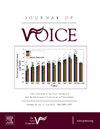Cannabinoid Use in the Treatment of Laryngeal Dystonia and Vocal Tremor: A Pilot Investigation
IF 2.4
4区 医学
Q1 AUDIOLOGY & SPEECH-LANGUAGE PATHOLOGY
引用次数: 0
Abstract
Objectives/hypothesis
Laryngeal dystonia and vocal tremor can be debilitating conditions with suboptimal treatment options. Botulinum toxin chemodenervation is typically the first-line treatment and is considered the gold standard. However, patient response to botulinum toxin varies widely. There is anecdotal evidence for the use of cannabinoids in treating laryngeal dystonia with a scarcity of research investigating this potential treatment option. The primary objective of this study is to survey patients with laryngeal dystonia and vocal tremor to gauge how some people are using cannabinoids to treat their condition and to ascertain patient perceptions of cannabinoid effectiveness.
Study Design
This is a cross-sectional survey study.
Methods
An eight-question anonymous survey was distributed to people with abductor spasmodic dysphonia adductor spasmodic dysphonia, vocal tremor, muscle tension dysphonia, and mixed laryngeal dystonia via the Dysphonia International (formerly National Spasmodic Dysphonia Association) email listserv.
Results
158 responses: 25 males and 133 females, (mean [range] age, 64.9 [22–95] years). 53.8% of participants had tried cannabinoids for the purposes of treating their condition at some point, with 52.9% of this subset actively using cannabis as part of their treatment. Most participants who have used cannabinoids as a treatment rank their effectiveness as somewhat effective (42.4%) or ineffective (45.9%). Participants cited a reduction in voice strain and anxiety as reasons for cannabinoid effectiveness.
Conclusions
People with laryngeal dystonia and/or vocal tremor currently use or have tried using cannabinoids as a treatment for their condition. Cannabinoids were better received as a supplementary treatment than as a stand-alone treatment.
大麻素用于治疗喉肌张力障碍和声带震颤:一项试点研究
目的/假设喉张力障碍和声带震颤可使人衰弱,治疗方案不理想。肉毒毒素化学神经支配通常是第一线治疗,被认为是金标准。然而,患者对肉毒杆菌毒素的反应差异很大。有轶事证据表明大麻素用于治疗喉肌张力障碍,缺乏研究调查这种潜在的治疗选择。本研究的主要目的是调查喉肌张力障碍和声带震颤患者,以评估一些人如何使用大麻素治疗他们的病情,并确定患者对大麻素有效性的看法。研究设计:这是一项横断面调查研究。方法通过国际语音障碍(原国家痉挛性语音障碍协会)电子邮件信箱向外展痉挛性语音障碍、内收肌痉挛性语音障碍、声带震颤、肌肉紧张性语音障碍和混合性喉障碍患者进行8题匿名调查。结果158例应答:男性25例,女性133例,平均年龄64.9岁[22-95]岁。53.8%的参与者曾尝试过大麻素来治疗他们的病情,其中52.9%的人积极使用大麻作为治疗的一部分。大多数使用大麻素作为治疗的参与者将其有效性评为有点有效(42.4%)或无效(45.9%)。参与者将减少声音紧张和焦虑作为大麻素有效的原因。结论患有喉张力障碍和/或声带震颤的人目前使用或曾经尝试使用大麻素作为治疗他们的病情。大麻素作为补充治疗比作为单独治疗更好。
本文章由计算机程序翻译,如有差异,请以英文原文为准。
求助全文
约1分钟内获得全文
求助全文
来源期刊

Journal of Voice
医学-耳鼻喉科学
CiteScore
4.00
自引率
13.60%
发文量
395
审稿时长
59 days
期刊介绍:
The Journal of Voice is widely regarded as the world''s premiere journal for voice medicine and research. This peer-reviewed publication is listed in Index Medicus and is indexed by the Institute for Scientific Information. The journal contains articles written by experts throughout the world on all topics in voice sciences, voice medicine and surgery, and speech-language pathologists'' management of voice-related problems. The journal includes clinical articles, clinical research, and laboratory research. Members of the Foundation receive the journal as a benefit of membership.
 求助内容:
求助内容: 应助结果提醒方式:
应助结果提醒方式:


